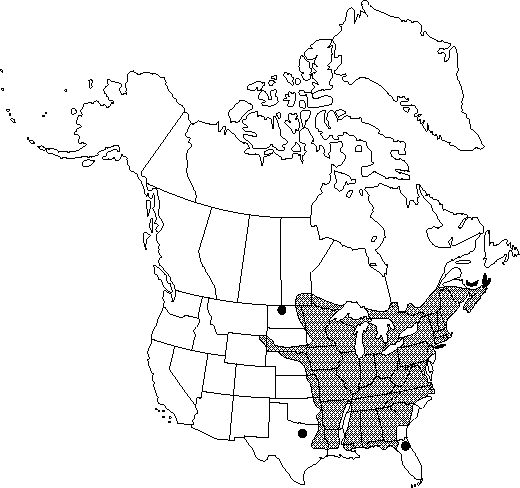Ostrya virginiana
Dendrologie 2(2): 8. 1873.
Trees, to 18 m; trunks short, crowns open, narrow to broadly rounded. Bark grayish brown or steel gray, shredding into narrow, sometimes rather ragged, vertical strips. Twigs sparsely pubescent to densely velutinous. Leaves: petiole glabrous to pubescent, without stipitate glands. Leaf blade narrowly ovate or elliptic to oblong-lanceolate, (5–)8–10(–13) × 4–5(–6) cm, base narrowly rounded to cordate or cuneate, margins sharply and unevenly doubly serrate, apex usually abruptly acuminate, sometimes acute or gradually tapering; surfaces abaxially sparsely to moderately pubescent (or sometimes densely villous), especially on major veins. Inflorescences: staminate catkins 2–5 cm; pistillate catkins 0.8–1.5 cm. Flowering with leaves in late spring. Infructescences 3.5–6.5 × 2–2.5 cm; bracts 1–1.8 × 0.8–1 cm. 2n = 16.
Phenology: Flowering late spring.
Habitat: Moist, open to forested hillsides to dry upland slopes and ridges, sometimes also on moist, well-drained flood plains
Elevation: 0–300 m
Distribution

Man., N.B., N.S., Ont., P.E.I., Que., Ala., Ark., Conn., D.C., Fla., Ga., Ill., Ind., Iowa, Kans., Ky., La., Maine, Md., Mass., Mich., Minn., Miss., Mo., Nebr., N.H., N.J., N.Y., N.C., N.Dak., Ohio, Okla., Pa., R.I., S.C., S.Dak., Tenn., Tex., Vt., Va., W.Va., Wis., Wyo.
Discussion
The shaggy bark and winter-exposed terminal staminate catkins of Ostrya virginiana permit easy recognition of this characteristic tree of dryish eastern forests. Along the Atlantic Coastal Plain, Ostrya virginiana, like Carpinus caroliniana, has smaller, blunter, often more pubescent leaves (O. virginiana var. lasia Fernald). This variety has not been studied carefully; from the available material, however, it does not seem as distinct as the coastal subspecies in C. caroliniana.
Native Americans used Ostrya virginiana medicinally to treat toothache, to bathe sore muscles, for hemorrhages from lungs, for coughs, kidney trouble, female weakness, cancer of the rectum, consumption, and flux (D. E. Moerman 1986).
Selected References
None.
